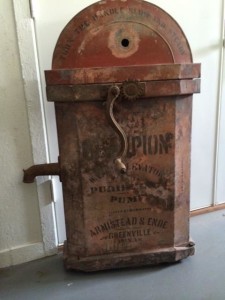
An old Champion Water Elevator was once located in 2600 block of Johnson Street in Greenville. It stood in front of the Armistead and Ende building completed in 1903. It is not known when the water elevator was installed. The cistern was uncovered in the 1950s or 1960s but nothing indicated if the water elevator was still there. Imagine getting drinking water or watering your livestock from such a marvelous invention. (Photo courtesy of author.)
Fires were the cause of so much damage and destruction of towns and cities throughout history. The other night I watched a PBS special on Westminster Abbey and the Houses of Parliament in London. What we know today as Parliament with the Elizabeth Tower and Big Ben was built after a destructive fire in 1834.
Greenville has had its share of disastrous fires. Between 1881 and 1883 two fires swept away a courthouse and the entire west side of the square as well as the new Ende Hotel located on the southeast corner of the square. Without a fire truck, the Greenville mayor telegraphed the fire department in Sherman for help. They loaded their fire truck, horses, and men on a special Katy train that sped to Greenville. Shortly thereafter, the town of Greenville ordered a new horse drawn fire engine, and built four cisterns at each of corner of the new courthouse. These cisterns became the fire hydrants of the day.
You may want to know what a cistern is. Today we call the process harvesting rain. Good gardeners put a large barrel at the corner of the house or other location to catch rainwater. The cistern collects the water for later use on plants. Old timers used cisterns to collect drinking water; my mother’s generation thought having rainwater to wash their hair was “the cat’s meow.”
One of those four cisterns the city built was located in the 2600 block of Johnson Street on the east side. Today the red brick Ende Building built in 1903 some years after the tragic hotel fire on the same location is the home of My Sisters’ Closet. Then it was Armistead-Ende Store that sold everything from farm necessities to the latest in cook stoves. As a marketing ploy, James Armistead who owned the business after the death of Fred Ende in1897 decided to install a water elevator on top of the cistern.
The water elevator and purifying pump was made of Japanned Cast Iron with an iron spout, a cast iron crank with hardwood handle and a small hole at the bottom for water to drain out to prevent freezing. It stood 41 inches high, 22 inches wide and about 8 inches deep. The interior was hollow to allow a chain mechanism to lower galvanized buckets into the cistern where water was brought up and dipped out into a flue that led to the spout. The spout was about 16 inches off the ground. The red frame proclaimed it a Diamond Water Elevator and Purifying Pump in black letters. James Armistead had “Armistead & Ende, Greenville, Texas” stenciled at the bottom. He probably ordered one from the Shapleigh Hardware Company of St. Louis at a cost of $19.50. There is no date on the water elevator or on the catalog from Shapleigh.
While the cistern was primarily for fire prevention, local citizens made use of the water elevator to pump water for their own use, for household use, and a nice cool drink for horses and mules. I read once that a major concern of the progressive women’s clubs was the “nasty” horse troughs around the square. The good ladies suggested a large watering place for all livestock well off the square. Whether the water elevator was an irritant to the women is not known. But it is certainly a wonderful piece of Greenville memorabilia.
